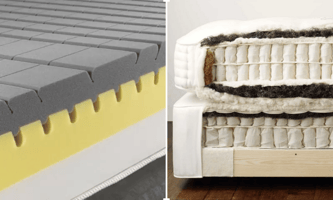Buying a mattress is no small decision, and it’s not a decision we make every day, either! A good...
Measuring Foam Density and What it Means for Your Furniture
Foam density…foam density… You know you’ve heard of it before, but you can’t quite put your finger on what it means. Or if it’s even an important thing to know as you shop for furniture. Is foam density something you can overlook, or is it a pretty crucial component of your next sofa or sectional?
Our in-house designers at McElheran’s Furniture + Design are known as Design Guides. And with over 60 years of combined industry experience, they can not only help you design a beautiful space, but they also offer a wealth of knowledge when it comes to those technical details, like foam density.
Even if you end up purchasing your furniture elsewhere, at least you know you can drop by our showroom for sound, professional advice that will get you closer to creating a space you’re proud of.
In this article, our Design Guides will discuss:
- What foam density is and how it’s measured
- What foam density you should look for
- Where to find foam density information
- Whether foam density affects the firmness of a cushion
- If foam density is different depending on the type of foam
And it would probably help you to know which foam density is going to work for you, so we’ll definitely get to that, too!
Just so you know, for the purposes of this article, we’ll stick to foam density as it pertains to furniture for seating, like sofas and sectionals.
What is foam density?
Foam density is the weight - usually in pounds - of a single cubic block (12” x 12” x 12”) of foam in a cushion. For example, if a cubic block of foam weighed 1.5 pounds, its foam density would be 1.5 pounds per cubic foot (or PCF).
Foam density is one of the many factors that help to determine the quality of your sofa or sectional. It can affect the overall price of the furniture, too.
In short, the higher the foam density, the better the quality. And generally, when you’re getting a higher quality product, it will last longer in your home.
What foam density should I be looking for?
Most seat cushions used for residential furniture hang out in the 1.5 to 2.5 pounds per cubic foot, with the industry average at 1.8 pounds PCF.
Foams that have less density are reserved for lower-end furniture or parts of the sofa or sectional that doesn’t support as much weight, like back cushions or arm padding. Higher densities, like 2.0 pounds PCF and up can be found in the seats of luxury furniture.
Furniture that is specifically designed for heavy commercial use (such as restaurant seating) may use foam with an even higher density, like 3.0 or higher.
Your foam density, depending on the grade, could really take your furniture from being relatively temporary to more of a long-lasting, investment piece.
Where can I find foam density information?
Most retailers and certainly furniture manufacturers will have access to the foam density within your furniture, so feel free to ask about it as you shop around!
Also, if you are looking at buying high-end furniture you can almost guarantee that it will come with cushions that use good quality, high density foam.
Your warranty information may also provide insight into the furniture’s foam density.
Foam density vs. firmness
A common misconception about foam density is that it affects the firmness of your seat, but the firmness of your cushion core actually has very little to do with the density and how long your foam will last.
Unfortunately, since many people equate density with how firm a cushion sits, some retailers may try to promote cheaper, low-quality foams as “extra firm” to hide the fact that the density and quality are actually pretty low.
What we’re trying to say is that foam density and firmness are two separate things that have very little correlation with one another. Foam density represents the quality and durability of the foam, while firmness is, well, how firm your cushion sits.
To further emphasize this point, you should know that any degree of foam density can also sit anywhere from soft to extra firm. So, you can get a foam with high density that’s plusher and allows you to sink in your seat and vice versa! You can also find low-density foam that is quite firm.
Are there different densities depending on the type of foam?
All foam is measured the same way to find out the density. So, no matter the type of foam, you’re always looking at how much it weighs per cubic foot.
And since we’re on the subject, there are a few different types of foam that you may come across in the seating of your furniture.
Polyurethane (PU) foam
Polyurethane foam is a porous synthetic material that is used more than any other foam in sofa and sectional cushions.
It offers insulation, absorption, and flexibility, and comes in a multitude of densities. And since density equals quality, PU foam can be found in a variety of furnishings ranging in quality.
Soy-based foam
Soy-based cushions are often marketed as green or eco-friendly, but keep in mind that only a small percentage of the foam is made from soy. The majority is still made up of polyurethane.
The reason why? Soy kind of gives off an unpleasant odour as it off-gasses.
All foam off-gasses, by the way. In fact, most new products - regardless of what they are - have a brief off-gassing period. Off-gassing occurs when organic compounds are released into the air after a product has been made or unpackaged.
Memory foam
Memory foam is most commonly used in mattresses, but occasionally, a thin layer of memory foam is used to top the core of a sofa cushion.
The great thing about memory foam is it inherently conforms to your body to better support you. The downside, though, is the memory foam takes longer to “bounce back” once you leave your seat.
High resiliency foam
High resiliency (HR) foam is usually found in top-tier quality sofas. While all foams will deteriorate somewhat with time, an HR foam will hold its shape longer.
To qualify as high resiliency, a foam has to have the density of at least 2.5 pounds per cubic foot. HR foam also has high responsiveness, so it returns to its original structure faster than other foams.
What foam density should I get for my furniture?
We cannot stress enough that density is all about quality and durability, so it’s important to think about how long you want your sofa or sectional to last.
On the lower end of density, cushion cores with 1.8 pounds PCF should last you three to five years with regular use. If you are buying a sofa with a higher foam density, let’s say 2.4 pounds PCF, it would not be unheard of to get 10+ years out of that foam with proper maintenance.
And what is proper maintenance exactly? Feel free to read Sofa Maintenance to find out more about how to extend the life of your sofa and the foam inside your cushions.
You can also drop in for a visit to McElheran’s. Our Design Guides are ready to answer any questions you may have about foam density or assist you with anything else you need so you can find that perfect piece for your space.

-min.jpeg?width=1000&height=667&name=AdobeStock_392469423%20(1)-min.jpeg)





